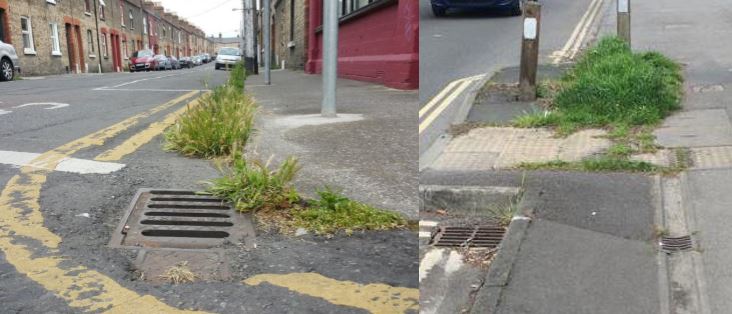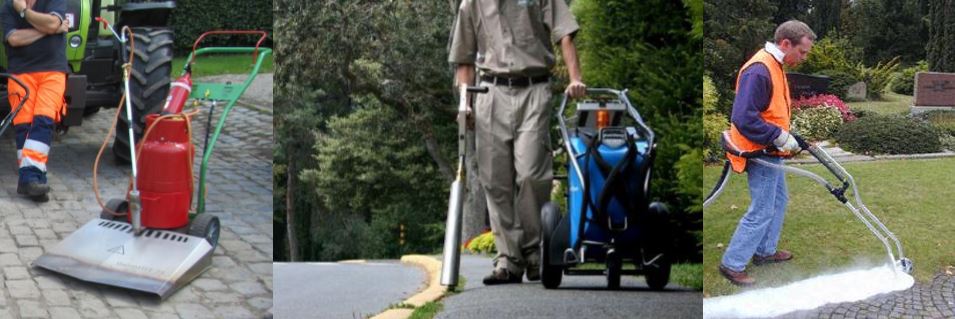Dublin City Council planning for a herbicide free city

August 15th, 2017
Herbicides are widely used throughout Ireland to control weeds, but there are growing concerns surrounding the damage these chemicals may be doing to our health and to the health of the environment. We talk to Shane Casey, a Biodiversity Officer for Dublin City Council, about alternative weed control, Dublin County Council’s proposed pesticide reduction strategy, and the issues to be faced in implementing the new measures throughout Dublin.
The Problem with Herbicides
Glyphosate is the best known of the herbicides as it is an active ingredient in the popular weedkiller ‘Roundup’. In March 2015, the International Agency for Research on Cancer (IARC) – the World Health Organization’s specialized cancer agency – classified glyphosate as “probably carcinogenic to humans”. Since then a petition has gained 1.3 million signatures from around Europe calling for a ban on this chemical. There are also concerns about the damage herbicides may be inflicting on the biodiversity of our natural surroundings as herbicide use not only kills the pl t, but leaches into the soil and water table.
“The dangers of different herbicides are well publicised,” says Mr.Casey. “Our proposed pesticide reduction strategy is not responding to any one danger, but rather looking at the questions of “‘should we be doing this in the first place” and “is there a more natural approach to management?”
Glyphosate-based herbicides make up the majority of products currently used by Dublin City Council. Three departments are responsible for undertaking weed control: parks and landscape, road maintenance and housing maintenance. Over the course of 2014, 3,458 litres of glyphosate-based herbicides were used throughout these departments.
Alternatives to Herbicides
Mr Casey outlines five weed control options that could be used instead of chemical herbicides.
- No weed control: In some cases, weeds are flowering plants that provide valuable food sources for pollinating insects. In some areas, such as around trees or in certain parts of parks, these plants can also be aesthetically pleasing, providing natural enrichment. Allowing weeds to grow would need a change in people’s perspective as to what a weed really is and why they can be valuable to wildlife and to us.
Prevention: While it’s not possible to prevent 100 per cent of weed growth, there are several measures which would suppress weed growth, including a more regular cleaning programme of footpaths and gullies to prevent a build-up of growing substrates. Hand-held and Tractor-mounted weed brushes have been successfully used in other cities.
Manual Weeding: Manual weeding of tall weeds is typically easier than manual weeding of low weeds or weeds in cracks and crevices. Manual weeding could also keep target plants while removing unwanted weeds.
- Strimming: Strimming grass at the base of trees, walls, or in tight corners is achievable but requires extra care by the operator. Additionally, tree guards can be put in place to prevent damage to trees.
- Novel techniques: Thermal weeding (flame or hot air), foam, steam, hot water weeding, and vinegar have been trialled in different countries with varying degrees of success. Novel techniques may be appropriate in certain situations but would need to be tested on a case-by-case basis within Dublin City. Some of these techniques are already being tested here in Dublin with varying degrees of success.

Challenges in Reducing Herbicides
There would be many difficulties in implementing such a change including “public acceptance,” according to Mr Casey. “The theory of colourful wildflowers in the absence of herbicides does not tally with the reality of overgrown grasses. [There are] issues around litter and other items in tall vegetation likely to concern those responsible for its management. ‘Unkept’ areas [can be] perceived as a sign of neglect or negligence.” The changes required to reduce herbicide use would need public understanding and acceptance, so a level of consultation and relay of information would be needed.
Mr.Casey adds: “We don’t expect an overnight elimination of herbicide use. Our short term aim is to focus on areas where herbicide reduction or elimination is easy or straightforward, and use these as models for other areas.”
In Parks and Landscape Services
Currently, herbicides are used to prepare flower beds, along with grass verges, the bases of walls, and bases of trees. In flower beds, a lot can be gained from mulching and appropriate plant selection. Strimming or manual methods can replace herbicide use at the base of walls and along grass verges, or where the frequency of visitors is low the grass can be allowed to grow untended. Strimming could also be used around trees, with the use of tree guards to protect the trunks.
In Road Maintenance
On public roads, laneways, footways, and medians, weeds are currently sprayed twice annually, at the beginning and end of the Summer. Weeds in these areas could successfully be managed once at the beginning of Summer, using hand-held or tractor-mounted weed brushes. The city centre, village centres and main roads could be managed a second time at the end of Summer using the same techniques.
In Housing Maintenance
Within housing complexes, herbicides are currently used three times annually. Again it is proposed that herbicides will not be used. Hard surfaces could be managed twice annually, at the beginning and the end of summer, using scuffle hoes and hand-held weed brushes. In areas where manual techniques prove too time-consuming, alternative methods, such as power-hosing, could be trialled.
In the Community
Getting communities involved in the upkeep of their own area is also something that can be promoted. Currently, the council will provide bags and equipment to dispose of green waste. It is proposed that these facilities are advertised effectively, giving Tidy District groups, as well as community, business and voluntary groups the tools to help control weeds in their own area. Many communities already engage in these activities.
A Green and Vibrant Future
The absence of herbicides and a different approach to managing our green spaces could have huge implications on the biodiversity within our city. Some parks and community areas are already working to reduce their herbicide use. Markievicz Park is an example of one of a number of ‘Green Flag’ parks within the city which are actively reducing their use of herbicides. This is being monitored as part of the Green Flag award criteria.
The future of our parks and green spaces are at a crucial junction. If we can accept the possible changes and overcome the difficulties involved in such change, then it may mean a greener and more diverse future for our city and for those throughout Ireland.
[x_author title=”About the Author”]










